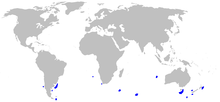Southern sleeper shark
The southern sleeper shark or Whitley's sleeper shark (Somniosus antarcticus) is a deepwater benthopelagic sleeper shark of the family Somniosidae found in the southern Atlantic, Indian, and Pacific oceans.[1] It is known from depths of 400 to 1,100 m.[1][3] Its length is up to 4.4 m (14 ft).[3] It feeds primarily on cephalopods, especially squid and fish; its stomach contents also less commonly contain remains of marine mammals and birds.[1] Based on its generally sluggish nature and the speed of its prey, it is thought to be an ambush predator.[1] A 3.6-m-long female caught off the coast of Chile had a whole southern right whale dolphin in its stomach. This dogfish is sometimes taken as bycatch in the orange roughy and Patagonian toothfish fisheries; whether this poses a threat to the species is currently unknown.[1]
| Southern sleeper shark | |
|---|---|
 | |
| Scientific classification | |
| Kingdom: | Animalia |
| Phylum: | Chordata |
| Class: | Chondrichthyes |
| Order: | Squaliformes |
| Family: | Somniosidae |
| Genus: | Somniosus |
| Species: | S. antarcticus |
| Binomial name | |
| Somniosus antarcticus | |
 | |
| Range (in blue) | |
This fish was formerly sometimes viewed as conspecific with either the Greenland shark, Somniosus microcephalus, or the Pacific sleeper shark, Somniosus pacificus.[4] In comparison, the southern sleeper shark differs from S. microcephalushas in having more tooth rows in the lower jaw, a shorter interdorsal region, a more posterior first dorsal fin, and fewer precaudal vertebrae, and from both species in having lower dorsal fins.[4]
Conservation status
In June 2018 the New Zealand Department of Conservation classified the southern sleeper shark as "Not Threatened" with the qualifiers "Data Poor" and "Uncertain whether Secure Overseas" under the New Zealand Threat Classification System.[5] The IUCN also does not regard it as threatened, noting a widespread distribution and no indication of a declining population, but believes it is not naturally abundant and that much more data and understanding of its population, interactions and biology is needed.[1]
References
- Finucci, B. (2018). "Somniosus antarcticus". IUCN Red List of Threatened Species. IUCN. 2018: e.T41857A68643703. doi:10.2305/IUCN.UK.2018-2.RLTS.T41857A68643703.en. Retrieved 28 December 2018.CS1 maint: uses authors parameter (link)
- Whitley, Gilbert P. (1939). "Taxonomic Notes on Sharks and Rays". The Australian Zoologist. 9 (3): 242.
- Froese, Rainer and Pauly, Daniel, eds. (2012). "Somniosus antarcticus" in FishBase. February 2012 version.
- Yano, Kazunari; Stevens, John D.; Compagno, Leonard J. V. (2004). "A review of the systematics of the sleeper shark genus Somniosus with redescriptions of Somniosus (Somniosus) antarcticus and Somniosus (Rhinoscymnus) longus (Squaliformes: Somniosidae)". Ichthyological Research. 51 (4): 360–73. doi:10.1007/s10228-004-0244-4.
- Duffy, Clinton A. J.; Francis, Malcolm; Dunn, M. R.; Finucci, Brit; Ford, Richard; Hitchmough, Rod; Rolfe, Jeremy (2018). Conservation status of New Zealand chondrichthyans (chimaeras, sharks and rays), 2016 (PDF). Wellington, New Zealand: Department of Conservation. p. 11. ISBN 9781988514628. OCLC 1042901090.
